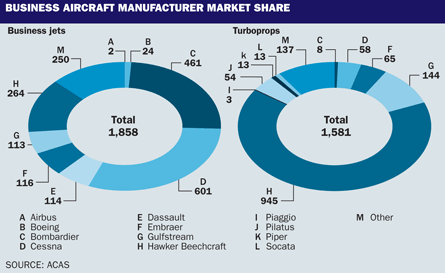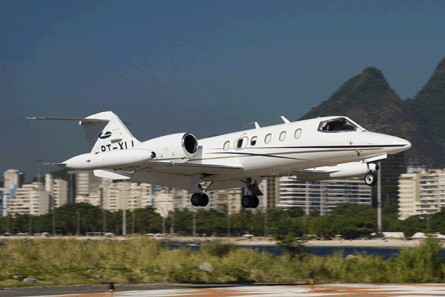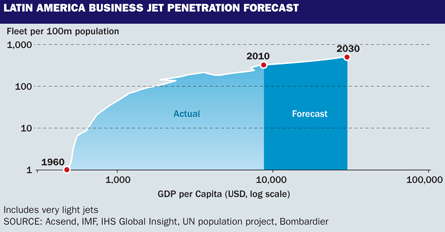Latin America has transformed over the past decade. Once ravaged by political and economic instability, the region is now among the world's most prosperous, largely shielded from the financial crisis that beset many western economies.
Latin America's prosperity is reflected in the region's surging business aircraft fleets. "Since 2001, Latin American business aviation fleets have grown at a 9.1% compound annual rate - among the highest in the world," says Richard Aboulafia, vice-president of analysis at the Teal Group consultancy. "This isn't surprising, since all the growth drivers are there: strong economic growth, economies based on transplant manufacturing and resource extraction, spotty ground transport infrastructure and economically important regions that are relatively unconcentrated. Great business prospects and great geography, in short."
According to Bombardier's 20-year business aviation forecast, released last month, most countries within Latin America experienced strong to very strong economic growth in 2010, with an average growth for the region of 5.8%. Over the forecast period, Latin America's economy is to grow by 4.3% per year, on average.
 |
|---|
© Divulgation |
"This economy has traditionally been driven by exports of manufactured goods, agricultural products and natural resources, such as oil and minerals. Tourism is also an important driver, notably for Mexico and the Caribbean," said the Canadian airframer's report.
The buoyancy of Latin America's economy has helped to swell its billionaires tally, from 36 in 2009 to 53 last year, according to Forbes, and the region is home to the world's wealthiest individual, Mexican national Carlos Slim Helu.
"Business aviation has a long and well-established presence in Latin America, partly due to the poor scheduled airline service in the area," says Francisco Lyra, president of the Brazilian business and general aviation industry group Associação Brasileira de Aviação Geral (ABAG) - which will host the LABACE business aviation show being held from 11 to 13 August at São Paulo's Congonhas airport.
But given the industry's longevity here, it is unsurprising that the business jet fleet's average age,18.5 years, is about three years older than the rest of the world's, Bombardier says - and good news for aircraft makers, as demand for replacements is to soar. "Latin America is forecast to take delivery of 2,125 business jets - excluding very light and entry-level types - in the period from 2011 to 2030, with 925 aircraft between 2011 and 2020 and 1,200 deliveries between 2021 and 2030," says Bombardier. "The fleet per 100 million population is expected to grow from 315 to 500 over the next 20 years".
BOUYANT BRAZIL
The biggest success stories within the region are found in Brazil and Mexico, where thriving economies, booming commodity prices and progressive social policies have spawned an expanding, prosperous middle class.
Of the two countries, Brazil is considered the jewel in the region's economic crown. It is the world's second-largest market by country for business aircraft - after the USA - and has more than 1,100 turbine aircraft, according to Flightglobal's ACAS database, plus more than 1,000 helicopters - a popular mode for executives in traffic-clogged, security-conscious cities like São Paulo. Embraer's latest market forecast predicts demand for 550 new jets in Brazil over the next decade, generating revenues of $6.3 billion. "This volume represents almost 60% of sales in Latin America, and more than 5% of global demand over the next 10 years, outpacing the number of jets expected to the bustling Chinese market in the same period," says Claudio Camelier, marketing vice-president for Embraer Executive Jets.
 |
|---|
ABAG's Lyra agrees: "Brazil is the leader in Latin America." He attributes the country's market dominance and continued growth to two factors: "Firstly: structural - the country is continental in size, with 5,600 cities, but only 124 of these are served by scheduled airlines. In contrast, there are 4,000 airports and aerodromes in Brazil, of which 3,500 are served by business aircraft." Lyra believes the development of Brazil's infrastructure has been imbalanced, with too much concentration on large metropolitan areas, where the population growth has been huge. "Business aircraft are critical to the development of Brazil. They open up new towns and cities within this vast country by providing a transportation link to even the remote areas. With only 720 airports in Brazil with paved runways, propeller-driven aircraft are a lifeline to many communities."
The second factor helping to deepen the country's love affair with business aircraft is "circumstantial", says Lyra. "The cost of aircraft ownership has fallen dramatically since the economic downturn," he notes. "The stars are aligned in favour of the buyer. The thriving economy is creating wealthy people. The country's banks are offering favourable interest rates, and the value of the dollar has fallen against the [Brazilian] real."
Brazil is also courting outside investment, which is helping to bring employment to the country's commodity-rich regions. "Nineteen percent of Brazil's GDP is due to direct investment throughout Brazil," says Lyra. "Many of these investors travel by business aircraft, so they can see first-hand what they are investing in. Many of the [most] remote regions are only accessible by turboprop and piston aircraft."
 |
|---|
It is a view echoed by Keith Nadolski, Americas president for turboprop and piston sales at US airframer Hawker Beechcraft: "Brazil is home to the largest installed base of King Airs [with around 400 aircraft]. The twin-engined turboprop has been hugely successful in Brazil due to its size, range and short field capability."
He says Latin America as a whole is now its largest market for new Beechcraft types - which also include the Premier IA and the Hawker 200 business jet, still under development. "We have 50 years' experience on the continent, and we are well entrenched in the government, VIP and commercial markets through our established network of local dealers."
Hawker's Beechcraft's Richard Emery - who has the same role as Nadolski, but for business jet sales - says these dealers are "deeply embedded in Latin American culture, and can run many of the economic and regulatory hurdles".
FINANCIAL HURDLES
He suggests that selling new aircraft in the region can be a challenge, particularly in Brazil, where strong nationalistic tendencies favour local manufacturer Embraer. "It has the advantage of being able to offer attractive financing packages and interest rates to Brazilian customers through various government agencies."
Still, Latin America is the largest market for new Hawker sales in the Americas, with the midsize 900XP its current biggest seller.
"Mexico and Columbia are particularly strong, but there is a lot on interest in our top-of-the-range [super midsize] Hawker 4000 from Brazilian customers," says Emery.
He argues that while Mexico "recognises the value proposition of new aircraft", the Brazilian marketplace is more "deal-driven", so it is standard practice there to buy a used aircraft.
This is a view supported by fellow prop and jet builder Cessna, which boasts the largest fleet of business jets in Latin America - with over 600 Citations. Trevor Esling, vice president of international sales, says: "New aircraft sales are relatively small, but demand for used aircraft is solid." But Brazil and Mexico will account for sales of around 30 and 10 Cessna aircraft respectively this year, Esling predicts.
"Brazil is the 800lb gorilla in the market, accounting for more than 50% of the region's [Caravan and Citation] fleet. The mean age of the business aircraft fleet is much higher than the global average - particularly in Mexico, where 80% of the aircraft are more than 20 years old - so the potential for new aircraft sales is huge," he adds.
 |
|---|
© AirTeamImages.comBusiness aircraft are a growing market in Latin America |
Esling observes a shift towards large-cabin and long-range aircraft, as more companies and individuals trade globally. This transition is frustrating for Cessna, which mothballed its large-cabin contender - the Columbus - two years ago, due to financial constraints. "We would like to see the Columbus relaunched eventually," he says.
For traditional builders of large and long-range business jets, Latin America is fertile ground. "Latin America accounted for 3% of Gulfstream sales in 2001. Ten years later this share has increased to 8%," says Gulfstream's regional senior vice president for international sales, Roger Sperry. "Up to two years ago Mexico was our largest market, but Brazil has moved into first place."
Last month the US-based airframer clinched Brazilian approval for the midsize G150, which it hopes will provide a replacement to many of the ageing midsize types in operation. But Gulfstream's large-cabin, long-range G450 and G550 make up two thirds of its installed base, and the manufacturer expects this tally to rise as international trade increases.
"Many companies are increasing the amount of trade they are doing internationally - particularly with China - so there is a greater demand for long-range business aircraft which can fly directly to their chosen destination," Sperry says. "With the [ultra-long-range] G650 coming on line [next year], we are well positioned to take advantage of this growth."
Bombardier's regional vice-president of sales, Fabio Rebello, agrees: "China has become the largest international trade partner for Brazil in the past 18 months, and is looking to the country for its raw materials. Consequently there is a trend towards purchases of large-cabin aircraft." Rebello says Bombardier is well positioned with its top-end Global 5000 and 6000, and has thrown down the gauntlet to large-cabin rivals with the ultra-long-range Global 7000 and 8000, to enter service in 2016 and 2017 respectively.
It won't be any easy task to topple Dassault from the top spot in Brazil, however.
"We have the largest installed base of large-cabin aircraft here and we intend to maintain the leader's position," says Dassault Falcon Jet president John Rosanvallon. "Brazil already accounts for 6% of the worldwide market for the long range 7X."
Rosanvallon says Dassault is targeting "large companies with internal businesses such as finance, beer and orange juice, which they are keen to export worldwide" .
AIRPORT ACCESS
As businesses thrive and expand across Brazil, airport infrastructure is struggling to cope with the increasing demand, both from business aircraft and commercial airlines. "Scheduled routes are growing at a rate of 20% a year, as airlines introduce new routes to towns where businesses are flourishing," says ABAG's Lyra.
 |
|---|
This has placed a strain on some airports - notably Congonhas in São Paulo, where business aircraft are allocated four slots per hour.
"We are calling on the government to invest in a new dedicated business airport with international capabilities," Lyra continues. "Policymakers must take this issue seriously now, so we will have enough capacity to cope with the demand for the 2014 World Cup and 2016 Olympics - both being hosted in Brazil."
Argentina, Chile, Columbia, Ecuador and Guatemala also show promise. But Venezuela - previously a hotbed of business aircraft activity - has slowed in recent months. Economic turmoil within the country and doubts about the ability of president Hugo Chavez to micromanage affairs of state from a Cuban hospital have led to instability within the county.
"The political [and economic] landscapes are always changing across Latin America," says Hawker Beechcraft's Nadolski.
Source: Flight International
















